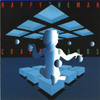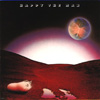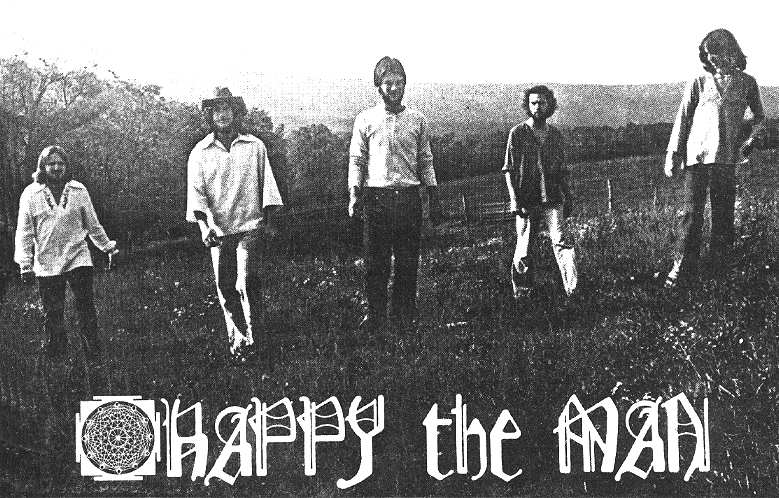
The Greatest Band You've Never Heard Of: The Story of Happy The Man

The Greatest Band You've Never Heard Of: The Story of Happy The Man
"It's like stepping back in time," writes one admirer; "I feel like I've discovered the Holy Grail," says another. A reviewer for New Gibralter Progressive Rock Encyclopedia writes: "HTM produced some of the most stirring, complex, melodic, and MUSICAL works I have ever heard."
I came to know of Happy The Man in 1982, while as a high school senior. An oddball--never given to New Wave or Top 40--I was addicted to progressive rock and so were all my friends: early Genesis, Yes and Pink Floyd, Gentle Giant, and maestros as John McLaughlin and his Mahavishnu Orchestra, Steve Morse and the Dixie Dregs, and French electric violinist Jean-Luc Ponty. Thinking-man's music. Call it a "cast of mind": Why some enjoy watching Gilligan's Island and others prefer a Discovery Channel documentary on life in a coral reef. Who knows?
But on the day that I stopped into Tower Records, a lifetime ago, and read in the then-latest in-house Tower music magazine that Peter Gabriel considered something called "Happy The Man" his "favorite band," I endeavored to know everything there was to know about this mysterious confederation.
The first years of HTM's existence were fraught with the usual hits and misses. Keyboardist Christopher "Kit" Watkins, son of a classical composer and James Madison university professor father, provided much of the band's chops in the early days, drawing upon improbable time-signatures (5/4, 11/9) and creating unique textures, a la Brian Eno, with his Moog synthesizer. A little too derivative of very early-Genesis, early on, perhaps, as the "airy-fairy" "Gretchen's Garden" (from the newly-released Beginnings CD) proves. And there was always a struggle with the concept of using the services of a vocalist. (The battle was lost when Cliff Fortney departed, sensing the band's desire to head in the direction of symphonic music, allowing the band to concentrate on composition and experimentation in rhythm. All-told, in three official Happy The Man LPs, only six tracks contain lyrics, which are brought off ably by guitarist Stan Whitaker, though prog-rock purists like to bitch about it.)
By 1976, roadie friends for Genesis and Little Feat began popping in and out of the band's communal home in Reston, VA, to listen to the newest licks and spoke to Happy The Man in whispers of great things in the offing, if only they'd stick around. It was about this time that Whitaker would step up and, in a collegial way, begin competing with Kit Watkins and woodwinds-man Frank Wyatt for songwriting credit. And is also when Peter Gabriel discovered Happy The Man.
Recalls Whitaker: "Peter came to the Happy the Man rehearsal warehouse in, I believe, the Arlington area (on the Virginia side of Washington D.C.) on June 26th, 1976. I remember distinctly because it was Amerika's bi-centennial and the day before my birthday. I had met him at a couple of Genesis concerts previously and I remember him once saying to me after some question on spiritual beliefs, "I'm a warbler...", which he said was a British warlock...okay...needless to say he is a bit of a foreboding character, one of my favorite singers/artists/performers of all time and I'm sure we were all just a wee bit nervous about meeting him and playing with him. (Especially with him walking out on the previous bands shortly after arriving...)
"He spent over seven hours with us. We had very natural chemistry with him. He seemed a little 'spacey' when he would sit at the piano to play us one of his new songs. He would stop singing in mid sentence while holding the piano chord down... and then 'out of nowhere' he'd seemingly come back into his body and continue singing right where he left off! I remember looking at each other and nudging each other like "what the fuck...is he doing!" Talking about it now, I realize the songs were so new and fresh to him (first post-Genesis stuff ever) that he didn't really know exactly where they were going without a band's input...and would pause to 'channel' in a little more; or, shit, maybe he just forgot the words!
"We mostly concentrated on two songs: "Slowburn" and "Down the Dolce Vita" [from Gabriel's first solo LP, 1977]. We had them both sounding pretty tight as a band and you could tell Peter was digging it. He was starting to loosen up a bit and actually smile. He wanted to leave with a tape of those two songs w/o vocals (probably so he could tighten up the vocals and lyrics) which we gladly gave him. Shit, we were 21-22 years old, we were close to being signed to Arista Records, and we were playing with Peter-fucking-Gabriel! Life was good..."
Sometime in late-76, the band found its groove; and through a series of jaw-dropping concerts at the long-running Cellar Door Theatre, Washington, D.C., which attracted an A&R guy from Arista Records, run by the legendary (love him or hate him) Clive Davis, who brought it all together and provided for the group a 48-track studio in the Big Apple. "At first he didn't get it," says Arista's Rick Chertoff, of Davis's take on Happy The Man, after its official studio audition. "You could hear a pin drop in that studio. But I stood up and began clapping."
Mr. Davis, who was and still is accustomed to courting pop divas--from Whitney Houston to Britney Spears--deferred to his A&R associate, and Happy The Man was signed to a five-year series of renewable one-year deals. He would also call upon the production services of Ken Scott, a recording legend, engineer and producer of David Bowie (Ziggy Stardust, Aladdin Sane, Hunky Dory), the Dixie Dregs (Night of the Living Dregs) and Supertramp (Crime of the Century).
Founding members of Happy The Man recall Mr. Scott as both a harsh taskmaster and encouraging father, demanding due diligence and studio perfectionism of his young new talent-pool, but giving everything in return.
On meeting Scott, Kennell says now: "When we were discussing `shoot for the moon' dream producers, we made a list of our favorites, in order. Ken Scott was #1 as we were all blown away with the sound and intensity of the Birds of Fire album Ken had done for Mahavishnu Orchestra, and of course his involvement in the Beatles "White" was also mind blowing to us (not to mention Jeff Beck, Stanley Clarke, Billy Cobham, Supertramp, David Bowie, Elton John etc. etc. etc.) Arista sent our tape to Ken and he was knocked out. He was on the phone to us the same day and set up a live audition the following week."
The self-titled Happy The Man did miserable box-office, but pulled together fans and music reviewers the world over. The venerable and commercial Billboard wrote, of the debut, "Happy's sweeping and lushly arranged orchestrations are clearly innovative, if not hypnotic"; while the mighty, irreverant Circus spake, "Happy the Man's debut album is some of the most energetic, evanescent, wonderous and colorful young American pioneer music I've heard." That and Arista's $250,000 investment and producer Scott were enough to keep most of Happy The Man marching forward.

The casualty was Mike Beck, HTM's original drummer and a core personality in the band, who, following its debut LP, would also go his own separate way, the strain of "trying to make it" in the Big Leagues being too much for him. (Wired magazine senior editor Ted Greenwald, long a Happy The Man fanatic, would reminisce that Beck's style of percussion was more akin to that of "a Picasso" than of drumming: "Dressed in leotards, he would circle a vast array of bells, blocks, timpanies, `painting,' as he went...I've never seen anything like it before or since.")
That Happy The Man caused not a ripple in the tide of American music, the twin gods of disco and punk reigning, made the decision a little less difficult for Beck.
Through a friend-of-a-friend was brought in drummer Ron Riddle, a veteran of several Boston bands, who had composed music and recorded with The Cars and its various solo incarnations. Riddle would also cull from his bag of tricks a long-suffering track co-written with former-Cars member Greg Hawkes, transforming the languishing melody into one of Happy The Man's most notable signature tunes.
[Author's note: I'm listening now on continuous Napster repeat to "Service With a Smile" from the Crafty Hands CD, and recall vividly my first acid trip, in 1983: seated as a child-Buddha in a college dormitory room, with this song as my Initiatory: the most indelible 2:37 I have ever heard: Bone-crunching rhythm section, a Moog that would shame Keith Emerson, guitar like a lightning bolt in your third eye. Shot right through to the Soul.]
Riddle recalls the recording of Crafty Hands having had "its share of tensions and anxieties. We spent days just getting drum sounds and Ken wanted me to hit as hard as I could. By the time we got to the actual tracks, my hands were like bloody stumps. We had to put some sort of plastic goo on them and I had to wear gloves just to get through the pain. Pushed to my limit, which is exactly the way I like it."
Crafty Hands dazzled music reviewers and bedeviled DJs. The Rolling Meadows (IL) Herald found it to be, "...a near perfect record...the compositions and musical virtuosity rival anything in progressive rock or jazz today"; while Columbia University's campus newspaper offered broader praise: "They [Happy The Man] lack the one great flaw their predecessors flaunt--pretension--and they know the mission of music--joy."
As they say, "That and a quarter will buy you a cup of coffee." With only one vocal track (the apocalyptic "Wind Up Doll Day Wind"), FM radio was able to ignore Arista's newest investment, though Peter Gabriel would remain interested in Happy The Man, an appreciation that would come to a crescendo in mid-77, ebb, and reemerge in 1979.
Recalls Stan Whitaker: "He would call (HTM manager) Bob Steinem's house, where we were staying, and talk to me at length about how Kit and I had especially blown him away. He offered up some other member suggestions but we were adamant about it being the whole band or none. He admitted he had no problem with that, because he liked the chemistry of our band. (Probably reminded him of early Genesis days.) He wanted the whole band alright, but he wanted it exclusively!
"My/our rap was that, `man, Peter, we'd LOVE to be your band, but we've worked six long hard years for a major record deal and have one 'on the table' with Arista... how can we give that up? We can't... but we CAN give your project priority and work the HTM stuff around your schedule.' We even joked about HTM being his opening act as well as his back-up band and we'd wear bags on our head during the HTM set...
"He spent a good 1 1/2-to-2 weeks calling us and talking with our and his manager to try to get us to go exclusively with him, but ultimately decided he didn't want to share us; and we, as a band, had to follow our hearts and do what we had worked so hard for. Thank god we did, since two very timeless, precious works of art (to us anyway) were created with Arista (even tho' they didn't know what to do with 'em or with us for that matter).
Frank Wyatt echoes Whitaker's take on Arista's lack of imagination. As to the proposed album cover for Crafty Hands, Wyatt recalls that an Arista official showed up to the band's house, with what was to be the final cover-art of band's second LP: "It was a delivery person, in a white uniform, staring through the peephole of an apartment, a bucket of fried chicken on his head and carrying a rubber-chicken, and and yelling "Service With a Smile!" I just about flipped. I drove all the way from Virginia to Arista's Manhattan headquarters and I would not leave until they agreed to replace it with something that wasn't hokey or humiliating."
"On a very personal note," recalls Whitaker, "when HTM broke up in 1979 (culminating with Kit leaving for Camel), I had an opportunity to join Peter again, as he was just beginning to write for his third album. I somewhat regrettably turned him down to continue to follow my own musical path. (I was just beginning to 'find my own voice' and was just starting to enjoy singing.)"
But what was once sweet turned bittersweet, then just got old: playing like ascendant Lords and living like hobos, never breaking out of the college campus and regional festival circuit, despite coast-to-coast raves in major metro dailies like the Washington Post and San Diego Union. Kit Watkins was lured away by the progressive band Camel, which turned out to be a mirage. Ron Riddle toured and recorded with Blue Oyster Cult, then back to session work and writing for TV and film. Stan Whitaker languished in Los Angeles, as a wannabe Rock Star for Tenn Jinn and others. Frank Wyatt moved to Hawaii, got married and divorced, saw his lifetime's collection of music, instruments and sound equipment stolen in a home-burglary. Bassist Rick Kennell went into music management in NYC.
The "band" itself, what was left of it, released an indie third LP in 1983, Better late... (Azimuth Records; rereleased in 1999 by Cunieform Records) with third drummer Coco Roussel (of the French electronic band Heldon), which rivals Crafty Hands in its craftsmanship, but which even hardcore HTM fans label, collectively, as "grim," much like Steely Dan's The Royal Scam--all business, and not much in the way of laughs, though who can blame them.
Gibralter Encyclopedia writer Paul Charbonneau says, of Better late...: "The edition of these 1979 recordings reminds us of just how regrettable the disappearance of this excellent group is. A music that defies description and a sound that isn't the least bit outdated. Always melodic, this unique blend of symphonic rock and jazz relies on rich arrangements of keyboards, guitars, bass, vocals, drums, percussions, flute and saxophone. The sustained use of these instruments provide much richness to the sound while solid performances provide dynamic energy. Five excellent musicians that played, we now realize, ahead of their time."
What might have been?
Happy The Man has reformed, playing four dates in 2000 with 4/5th's its Crafty Hands lineup, keyboardist David Rosenthal (Rainbow, Elton John) having replaced Kit Watkins, stage-shy now and master of his own Virginia-based Linden Music Studios. Frank Wyatt has just published his first collection of poetry, Oblivion Sun. The band unfurled recently its Web site, and a new CD of original tunes be slated for Fall 2002 release. A rare, fine wine. You can't rush it.
Don't ever give up.

Home | Books in Print | Interviews | Poetry | About Far Gone Books
Works in Progress | Hot News | Shit List | Class Acts | Email
Copyright © Far Gone Books 1996 -

Site Design by Circuit Traces Interactive
Webmaster